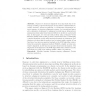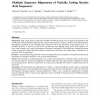38 search results - page 4 / 8 » Protein Multiple Alignment Incorporating Primary and Seconda... |
BMCBI
2006
13 years 7 months ago
2006
Background: Several entropy-based methods have been developed for scoring sequence conservation in protein multiple sequence alignments. High scoring amino acid positions may corr...
IMSCCS
2006
IEEE
14 years 1 months ago
2006
IEEE
Background: Hydrophobins are fungal proteins that can turn into amphipathic membranes at hydrophilic/hydrophobic interfaces by self-assembly. The assemblages by Class I hydrophobi...
RECOMB
2007
Springer
14 years 7 months ago
2007
Springer
Abstract. Sequence to structure alignment is an important step in homology modeling of protein structures. Incorporation of features like secondary structure, solvent accessibility...
BMCBI
2005
13 years 7 months ago
2005
Background: High quality sequence alignments of RNA and DNA sequences are an important prerequisite for the comparative analysis of genomic sequence data. Nucleic acid sequences, ...
CIBCB
2005
IEEE
14 years 1 months ago
2005
IEEE
— Part of the challenge of modeling protein sequences is their discrete nature. Many of the most powerful statistical and learning techniques are applicable to points in a Euclid...


